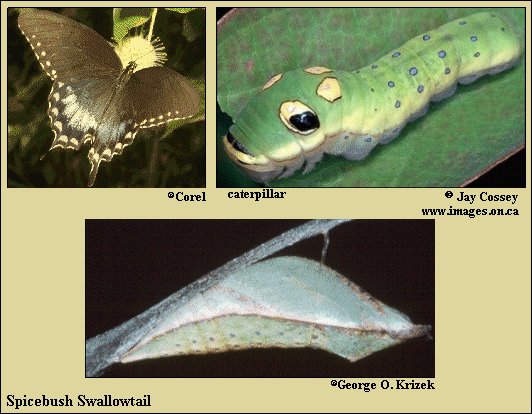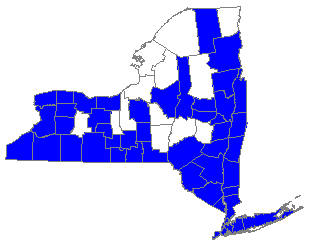 |
 

 |



Spicebush Swallowtail (Papilio troilus Linnaeus)
Wing span: 3 - 4 inches (7.5 - 10 cm).
Identification: Upper surface of forewing is mostly black with ivory spots along margin. Upper surface of hindwing has orange spot on costal margin and sheen of bluish (female) or bluish-green (male) scales. Underside of hindwing with pale green marginal spots.
Life history: Males patrol in woods, roads and woodland edges to find receptive females. Females lay single eggs on underside of host plant leaves. Caterpillars live in shelters of folded-over leaves and come out to feed at night. Some chrysalids from each generation hibernate.
Flight: 2 generations per year from April-October. In Florida, several generations between March-December.
Caterpillar hosts: Spicebush (Lindera benzoin), sassafras trees (Sassafras albidum); perhaps prickly ash (Zanthoxylum americanum), tulip tree (Liriodendron tulipifera), sweetbay (Magnolia virginiana), camphor (Cinnamomum camphora), and redbay (Persea borbonia).
Adult food: Nectar from Japanese honeysuckle, jewelweed, thistles, milkweed, azalea, dogbane, lantana, mimosa, and sweet pepperbush.
Habitat: Deciduous woodlands, fields, roadsides, yards, pine barrens, wooded swamps, and parks.
Range: Eastern states from southern Canada to Florida; west to Oklahoma and central Texas. Occasionally strays to North Dakota, central Colorado, and Cuba.
Conservation: Not usually required.
Management needs: None noted.
The Nature Conservancy Global Rank: G5 - Demonstrably secure globally, though it may be quite rare in parts of its range, especially at the periphery.
References:
Opler, P. A. and G. O. Krizek. 1984. Butterflies east of the Great Plains.
Johns Hopkins University Press, Baltimore. 294 pages, 54 color
plates.
Opler, P. A. and V. Malikul. 1992. A field guide to eastern butterflies.
Peterson field guide #4. Houghton-Mifflin Co., Boston. 396 pages,
48 color plates.
Scott, J. A. 1986. The butterflies of North America. Stanford University Press,
Stanford, Calif. 583 pages, 64 color plates.
Author: Jane M. Struttmann
State and Regional References:
Cech, R. 1993. A Distributional Checklist of the Butterflies and Skippers of
the New York City Area (50-mile Radius) and Long Island. New York City
Butterfly Club Special Publication. 27 pp.
Forbes, W.T.M. 1960. Lepidoptera of New York and Neighboring States. Part
IV: Agaristidae through Nymphalidae Including Butterflies. Cornell Univ.
Agricultural Experimental Station, Ithaca, N.Y. Memoir 371. 188 pp.
Glassberg, J. 1993. Butterflies Through Binoculars: A Field Guide to
Butterflies in the Boston-New York-Washington Region. Oxford Univ. Press,
New York, N.Y. 160 pp.
Klass, C. and Dirig, R. 1992. Learning about Butterflies. Cornell Cooperative
Extension Publication, 4-H Member/Leader Guide 139-M-9. Ithaca, N.Y.
36 pp.
Layberry, R.A., Hall, P.W. & Lafontaine, D.J., 1998. The Butterflies of
Canada. University of Toronto Press, Toronto, ON. 280 pp.
Opler, P.A. 1998. A field guide to eastern butterflies, revised format.
Houghton Mifflin Co., Boston.
Shapiro, A.M. 1974. Butterflies and Skippers of New York State. Cornell Univ.
Agricultural Experimental Station, Ithaca, N.Y. Search 4:1-60.

